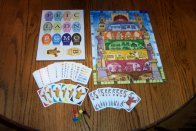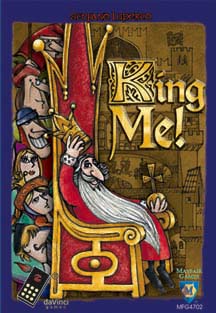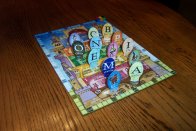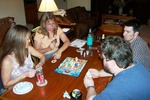
|
King Me! A game by Stefano Luperto Published by Mayfair Games, Inc. and da Vinci Games Players: 3 to 6 Ages: 8+ Time: 20-30 minutes Reviewed by Susan Rozmiarek |
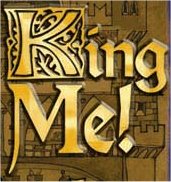
|
| "The enlightened monarch Vladimiro Miritiro, tired of reigning, has decided to choose his successor among his subjects. The players are helping him in this decision, by advising their favourites and trying to crown one of them as the new king." |
King Me! is the third offering, and first board game, from Italian company daVinci Games and is being published in the U.S. by Mayfair Games. The Italian version is called Viva il Re! and it follows daVinci's popular card game, Bang!, also published by Mayfair. Like Bang!, King Me! is another lighthearted game that emphasizes player interaction and fun, although it is by a different designer and is much different in theme and play.
Components:
The game comes with a small, single-fold board that shows a cutaway view of the castle and its floors along with the value of each. A scoring track wraps around the periphery and colored wooden cubes are provided as markers. There are thirteen candidates punched out of heavy cardstock with plastic stands to stand them upright. A small quibble, by being two dimensional, the characters cards are hard to identify on the board when viewed from the side. The cards are small, but sturdy. The secret goal cards each list six candidates that are color coded to match the figures. This, along with a prominent letter, makes it easy to find the candidates quickly. The art is simply wonderful with a very colorful and whimsical cartoon look. The game comes with a single color rulebook containing rules in English, German, Italian, French, and Dutch.
Game play:
The goal in King Me! is to score points by ending each round with your favorite candidates positioned on the highest levels of the castle preferably with one crowned as the new king.
The game consists of three rounds. Before the start of each round, each player is dealt a card that lists his six favorite candidates, which is kept hidden from the other players. In addition, he gets a set a voting cards that includes one "yes" vote and 2-4 "no" votes (depending on the number of players). The round starts with players placing characters one at a time on levels 1-4 of the castle. Each level can hold a maximum of four characters. Leftover characters are placed on the bottom level in the servant's quarters. The 5th level and King's Throne remain empty for now.
Each player, on his turn, must move one candidate up one level always following the restriction of no more than four per level. If the player moves a candidate to the topmost level, the King's Throne, a vote is immediately taken. Each player secretly chooses a voting card and they are then simultaneously revealed. If there are one or more "no" votes, the candidate has failed his succession attempt and is removed from the castle for the rest of the round and will not score. Any "yes" cards played are taken back into the owner's hands but any "no" cards are put in the box until the next round. Play now passes to the next player. However, if all votes are "yes" then the round immediately stops for there is a new king. Each player now checks his list of favored candidates and receives 0-5 points for each depending upon which level that candidate currently stands and 10 points if one is the new king. Now a new round starts with each player being dealt a new list. After the third round, the player with the most points is the winner. There is one interesting scoring twist in the third round only. If a player manages to score 0 points, he instead gets 33 points, the maximum possible score for one round.
Comments:
The feel is very lighthearted and simple, but there are plenty of interesting decisions to be made. The first is in the initial placement of the candidates. It will become quickly apparent that candidates placed at the top levels of the castle are usually voted on early and often voted out first, making it more desirable to place your favorites at the bottom and the others at the top. However, you have to weigh the fact that your placements might indicate to others just who your favorites are. So, there is a bit of a deduction element to the game. But, given that there are 13 candidates and each player has six as his favorites, there is quite a bit of overlap, making it too difficult and unnecessary to try to guess the other players' favorites, especially with more players. The deduction possibilities didn't really come in to play for me.
The alternative strategy of scoring zero points in order to receive the maximum of thirty-three in the third round provides a really interesting twist. It seems way too risky in the five and six player game, as you have much less control and only two "no" votes. With three and four players and more "no" votes though, it becomes a real temptation. I have only been able to pull it off once.
The really tense and fun moments in the game come with the voting. I just love this sort of bluffing mechanism and it is employed well here. Since each "no" vote can only be played once per round and the number of cards in each player's hand is hidden, it is important to keep track of how many "no" votes are still in players' hands. It is also tempting, early in the round especially, to vote "yes" for an undesirable candidate and hope someone else burns a "no" vote and throws the candidate out. However, if everyone pursues this strategy, which indeed happened in a few of my games, the round ends prematurely amidst a chorus of groans.
Timing is critical in this game. The probability of a new king being elected increases as more "no" votes are discarded and you want your candidates well positioned when the new king is crowned. It's quite fun to play this type of game multiple times with the same group of players so you can try to spot their playing patterns and plan accordingly. The fact that they might be trying to do the same thing makes it all the more interesting.
Summary:
While the game is not deep, it is quite fun and addictive.
It moves quickly and keeps everyone involved.
The tactical decisions involved in moving candidates up the levels combines nicely
with the bluffing of the voting.
At only 20-30 minutes a game, I can see this being a popular filler for my game group
as well as an enjoyable family game.
| Other Web information: |
This page viewed
E-mail Ed Rozmiarek with questions or problems concerning this page.
Copyright © 2003, Ed Rozmiarek
